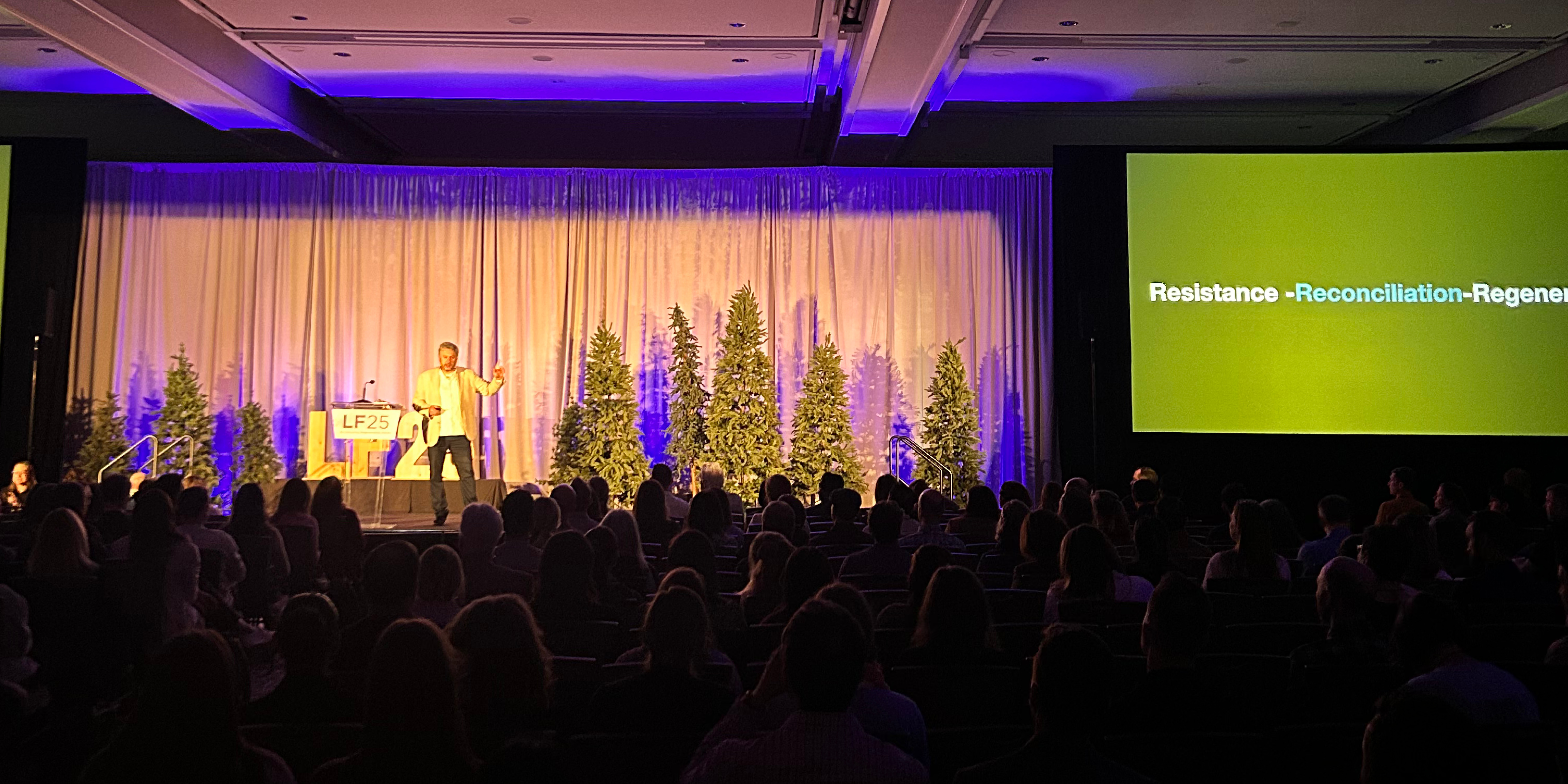Resist. Reconcile. Regenerate: The New Imperative in Sustainable Design


After an energizing and thought-provoking three days at the Living Future Conference, I left inspired, but also deeply reflective. One message stood out above all: the three Rs as we know them have changed.
As Jason F. McLennan reminded us, Resist. Reconcile. Regenerate is not just a slogan. It is a paradigm shift for everyone working toward a sustainable future. It challenges us to rethink how we engage with our work, our clients, our communities, and the planet.
- Resist the forces that continue to push environmental harm. If we don’t take a stand for the planet, who will?
- Reconcile with the harm already done to nature, to communities, and to future generations. Reconcile with those that challenge our point of view, because we must find solutions together.
- Regenerate the systems we touch, so every space, every building, every decision becomes a catalyst for healing and renewal.

While the conference was full of innovative case studies and visionary projects, the most powerful takeaway for me wasn’t the what, it was the how we move forward. As sustainability professionals, we must acknowledge a difficult truth: we’ve fallen short. But why have we been falling short? Building codes typically reflect minimum requirements rooted in historical performance, not future-oriented climate goals. By contrast, the SBTi carbon budget, covering both operational and embodied emissions, gives us a scientifically grounded trajectory that aligns with the Paris Agreement. According to the United Nations emissions are projected to increase by 3% by 2030, whereas they needed to decrease by 43% from 2019 levels. Harm reduction is no longer enough. It’s time to shift our focus and energy toward regeneration and accelerate actions.
Here are 10 key insights from the conference, backed by practical approaches and real-world examples that can help guide us on this critical journey:

1. Start with the Client’s Vision, Not Just Certifications
No matter how complex or undefined a client’s sustainability goals maybe, our job is to help them find clarity. A simple “Good, Better, Best” matrix can be a game-changer. By distilling choices into a prioritized framework, we can elevate the most impactful sustainability strategies, even when formal certifications aren’t part of the brief.
This isn’t about checking boxes. It’s about understanding intent, mapping out possibilities, and making sure that the key decisions foreach project are strategic, feasible, and aligned with long-term positive impact.
2. Design for Both Performance and Experience
Regenerative design isn’t limited to technical strategies. Low-carbon materials, high-efficiency energy systems, smart meters, and hazard-resilient structures are crucial, but are insufficient to achieve true sustainability. For that, we must focus our design around human experience.
Spaces that are connected to nature, that feel safe, calming, and restorative, directly impact our wellbeing. They help us decompress, reduce stress, and foster a sense of belonging. By supporting holistic health, buildings give us the foundation to our best work, to show up as our best selves. Regenerative design succeeds when it supports life at every level—technical, emotional, ecological.
3. Use Design as a Social Connector
We often underestimate the social power of our work. Our projects can be tools for community-building, fostering connection across tribes, cultures, and generations. By embedding equity and inclusivity into the design process, we can help distribute economic value to marginalized communities and amplify local voices.
Sustainability is the belief that we are worthy of each other’s respect, and are interconnected across oceans, generations, and species.. Regenerative design builds bridges, not walls.
4. Retrofit the Regenerative Mindset into Every Project
Whether it’s concept stage or post-construction, every project can integrate regenerative strategies. It’s never too late to make changes that improve ecosystem health and community wellbeing.
This includes:
- Improving soil conditions
- Enhancing biodiversity
- Increasing air and water quality
- Mitigating overall climate impact
No space is too small or too far along to make a difference.
5. Set Regenerative Metrics and Measure Them
We can’t regenerate what we don’t measure. To truly deliver positive impact, we must embed regenerative goals from the start with goals that are resilience-focused, data-informed, and outcome-driven.
Whether it’s an urban development or a hyperscale data center, regenerative design is achievable at scale. But only when we track progress toward nature-positive outcomes and let those results guide our next steps.
6. Unlock the Hidden Potential in Existing Buildings
Too often, we look at old, fossil fuel-based buildings as liabilities. But with the right approach, they can become symbols of transformation.
Biophilic design, nature-based strategies, and carbon-neutral retrofits can turn these buildings into community hubs, wellness sanctuaries, and climate-positive spaces . By shifting their narrative from “harmful past” to “regenerative future,” we rewrite the story of what’s possible in architecture and development.
7. Build a Coalition: Change Takes Collective Action
Big changes never happen in isolation. To decarbonize the industry and scale regeneration, we must work across boundaries, collaborating with clients, NGOs, policy makers, multidisciplinary teams, and even competitors.
Becoming signatories to global frameworks, aligning with industry coalitions, and pushing for collective impact is how we drive change faster and farther. Can your organization join The Climate Pledge? Are you ready to act in support of the UN Sustainable Development Goals? Sustainability is a team sport, and regeneration is the championship we’re playing for.
8. Let Biophilia Guide Every Decision
Nature isn’t just an aesthetic, it’s a blueprint for how to design better. Whether through materials, form, systems, or technologies, we must mimic natural systems and put biophilic principles at the heart of every project.
This could mean:
- Using carbon-neutral, natural materials
- Designing mechanical systems that mimic natural cycles
- Implementing smart tech that learns from ecological intelligence
At BranchPattern, we are inspired by the growth that emerges in natural systems. The closer we get to nature, the closer we get to truly regenerative outcomes.
9. Embrace Mass Timber for Climate and Community
Mass timber is one of the most promising solutions in the intersection of sustainable construction and rural economic development. But it must be done responsibly and holistically.
Healthy forest management is key. Non-managed forests are more fire-prone, releasing stored carbon when trees die. By sustainably harvesting mass timber, we:
- Prevent wildfires
- Maintain carbon sinks
- Support local economies
- Enhance biodiversity and disease control
It’s a win-win-win for the environment, for construction, and for small communities that depend on forestry.
10. Think Bigger Than Buildings, Think Systems
Regeneration doesn’t stop at the property line. Every project exists within a web of relationships to ecosystems, communities, and future generations.
We must stop asking, “Is this building doing less harm?” and start asking, “How is this project creating a of health, wellbeing, and vitality?”
The best regenerative spaces:
- Enhance ecosystems
- Support local economies
- Make people feel good
- Inspire replication
- And evolve with the world around them
That’s the future we must build together.

The Living Future Conference wasn’t just inspiring, it was a wake-upcall. The time for marginal improvements is over. The era of regeneration has begun. Let’s use our knowledge, our tools, our creativity, and our values to lead the way.
Resist. Reconcile. Regenerate.
Not just words, but the new compass for our industry.



View More Resources
Benefit from our expertise


